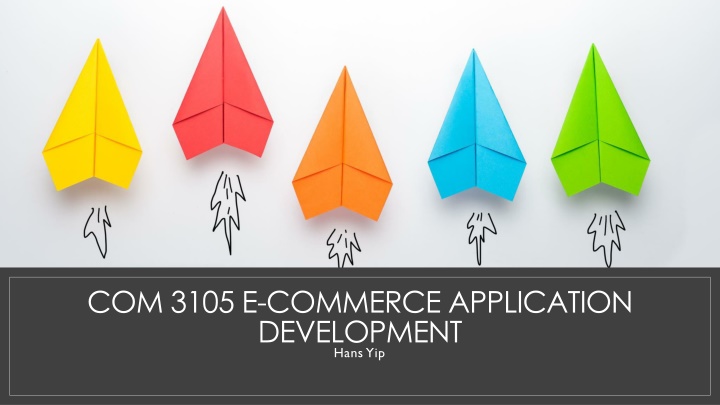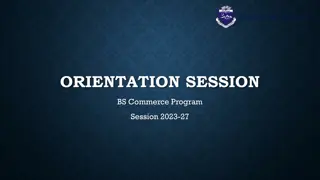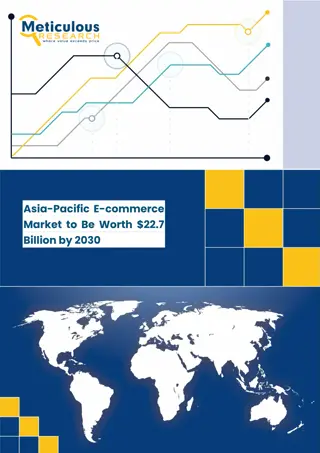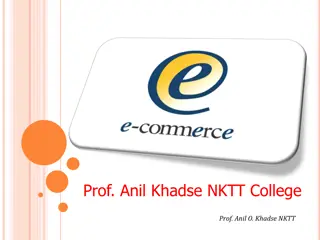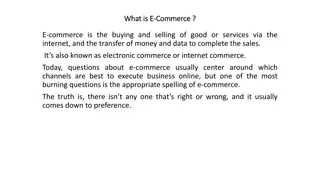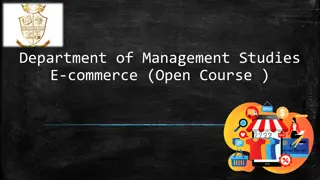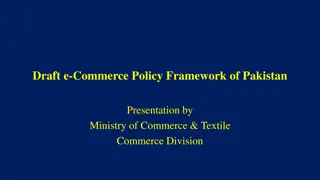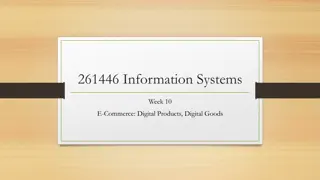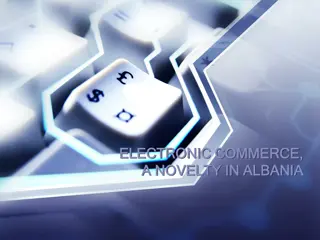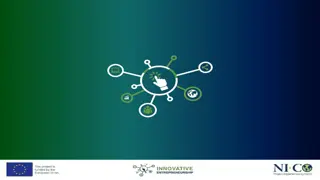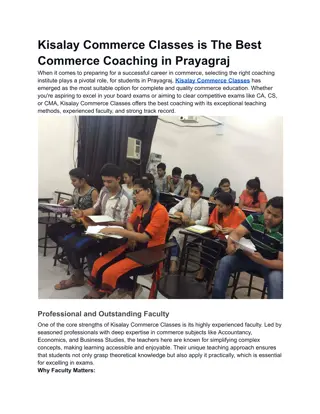Evolution of Electronic Commerce: From Past to Present
Electronic commerce has evolved over the years, from its beginnings in the mid-1990s to the present day, experiencing ups and downs. This chapter explores the growth of e-commerce, the impact of economic forces, and the international nature of online businesses. Learn about the history, trends, and opportunities in the ever-changing world of electronic commerce.
Download Presentation

Please find below an Image/Link to download the presentation.
The content on the website is provided AS IS for your information and personal use only. It may not be sold, licensed, or shared on other websites without obtaining consent from the author.If you encounter any issues during the download, it is possible that the publisher has removed the file from their server.
You are allowed to download the files provided on this website for personal or commercial use, subject to the condition that they are used lawfully. All files are the property of their respective owners.
The content on the website is provided AS IS for your information and personal use only. It may not be sold, licensed, or shared on other websites without obtaining consent from the author.
E N D
Presentation Transcript
COM 3105 E-COMMERCE APPLICATION DEVELOPMENT Hans Yip
Learning Objectives Chapter 1 Introduction to Electronic Commerce What electronic commerce is and how it has evolved in three waves of development Why companies concentrate on revenue models and the analysis of business process instead of business models when they undertake electronic commerce initiatives How to identify opportunities for and barriers to electronic commerce initiatives How economic forces have led to the development and continued growth of electronic commerce How businesses use value chains and SWOT analysis to identify electronic commerce opportunities How the international nature of electronic commerce affects its growth and development
Introduction Electronic commerce began in the United States and for many years was conducted primarily through English-language Web sites. Since 2013, China has been the leader in online retail sales, with a growing proportion of those sales being made on smartphones rather than computers. With a population of 1.4 billion, 650 million of Chinese have Internet connection, China is the world s largest potential online market. Although Chinese buyers do use U.S.-based sites such as Amazon and eBay, they are also frequent users of domestic sites such as JD.com and Tmall In this chapter, you will learn how online businesses have emerged and grown to accommodate the various cultures and infrastructure challenges around the world.
The Evolution of Electronic Commerce Electronic Commerce History: From the beginnings in the mid-1990s, electronic commerce grew rapidly until 2000. Then, major downturn occurred the dot-com boom had turned into the dot-com burst . Between 2000 and 2003, overly gloomy news reports (bad reports) related to e-commerce during this time. Beginning in 2003, electronic commerce began to show signs of a profound rebirth Companies see growth in sales again As the economy grew, electronic commerce also grew, but at a faster pace than the overall economy. Thus, electronic commerce gradually became a larger part of the total economy.
The Evolution of Electronic Commerce Electronic Commerce History: In 2008, general economic recession, electronic commerce suffered far less than most of the economy. By looking back, we can see that as the general economy has expanded and contracted, electronic commerce has consistently expanded more in the good times and contracted less in the bad times than other economic sectors.
Electronic Commerce and Electronic Business Electronic commerce means shopping on the web (World Wide Web). Electronic commerce (or e-commerce) also includes many other activities use to support their buying, selling, hiring, planning, and other activities. Some people use the term electronic business (or e-business) when they are talking about electronic commerce in this broader sense. Electronic business is the transformation of key business processes through the use of Internet technologies. (defined by IBM) Most of the people use the terms electronic commerce and electronic business interchangeable. Electronic commerce (or e-commerce) includes all business activities that use Internet technologies.(defined by this book) Internet technologies include the Internet, the World Wide Web, and other technologies such as wireless transmissions on mobile telephone networks. dot-com or pure dot-com companies operate only online to distinguish them from companies that operate in physical locations.
Categories of Electronic Commerce Supply management or procurement are departments devoted to negotiating purchase transactions with their suppliers. This kind of B2B electronic commerce is sometimes called e-procurement Other than buying and selling products, some companies may include manufacturing processes. Those manufacturing processes can be controlled using Internet technologies within the business. All of these communication, control, and transaction-related activities have become an important part of electronic commerce. Some people include these activities in the B2B category; others refer to them as underlying or supporting business processes.
Business Processes Business activity is a task performed by a worker in the course of doing his or her job Transaction is an exchange of value, such as a purchase, a sale, or the conversion of raw materials into a finished product. A transaction always has one or more activities associated with it, but an activity might not be related to a transaction. Business processes are groups of logical, related, and sequential activities and transactions in which business engage. Transferring funds, placing orders, sending invoices, and shipping goods to customers are all types of activities or transactions. For example, the business process of shipping goods to customers might include a number of activities (or tasks, or transactions), such as inspecting the goods, packing the goods, negotiating with a freight company to deliver the goods, creating and printing the shipping documents, loading the goods onto the truck, and sending payment to the freight company. Telecommuting or telework is allowing employees to work at home or from other locations instead of travelling to an office.
Relative Size of Electronic Commerce Elements Rough approximation shown in Figure 1-1 Dollar volume and number of transactions B2B much greater than B2C Number of transactions Supporting business processes greater than B2C and B2B combined
The Development and Growth of Electronic Commerce Early Electronic Commerce: Since the mid-1960s, banks have been using electronic funds transfers (EFTs, also called wire transfers), which are electronic transmissions of account exchange information over private communications networks. Initially used to transfer money between business checking accounts, the use of EFTs gradually expanded to include payroll deposits to employees accounts, automatic payment of auto and mortgage loans, and deposit of government payments to individuals, such as U.S. Social Security System remittances.
Early Electronic Commerce In the 1960s, electronic data interchange (EDI) occurs when one business transmits computer-readable data in a standard format to another business. Business realized that many of the documents they exchanged were related to the shipping of goods; for example, invoices, purchase orders, and bills of lading. Business realized that they were spending a good deal of time and money entering data into their computers, printing paper forms, and then reentering the data on the other side of the transaction. The purchase order, invoice, and bill of lading for each transaction contained much of the same information. By creating a set of standard formats for transmitting the information electronically, businesses were able to reduce errors, avoid printing and mailing costs, and eliminate the need to reenter the data. Trading partners are businesses that engage in EDI with each other. Firms such as General Electric, Sears, and Walmart were pioneers in using EDI to improve their purchasing processes and their relationships with suppliers. The US government was also bringing businesses into EDI. One problem that pioneers faced was the high cost of implementation. Until the late 1990s, doing EDI meant buying expensive computer hardware and software and then either establishing direct network connections (using leased telephone lines) to all trading partners or subscribing to a value-added network. A value-added network (VAN) is an independent firm that offers connection and transaction-forwarding services to buyers and sellers engaged in EDI.
The First Wave of Electronic Commerce, 1995- 2003 During 1997 and 2000, lots of Internet-related businesses started. dot-com boom . From 2000 to 2003, more than 5000 Internet start-up firms went out of business. dot-com burst It was characterized by a period of rapid growth and innovation, with many companies pursuing a first- mover advantage. This period included much experimentation with a wide range of revenue models and business strategies and developed primarily in the United States. Web pages were primarily in English, particularly on commerce sites.
The Second Wave of Electronic Commerce, 2004 - 2009 It became global expansion of electronic commerce driven by improvements in the technologies of the Internet and the Web. Digital product distribution grew dramatically as content providers came to terms with piracy and developed strategies for succeeding in the online environment. An increasing number of companies used a smart-follower strategy rather than pursuing a first-mover advantage.
The Third Wave of Electronic Commerce, 2010 - Present Beginning in 2010, mobile users who have powerful smartphones and tablet devices and are eager to do business and participate in social networking online. Other characteristics of the third wave include increased participation by smaller businesses, rapid electronic commerce growth in developing countries with large populations, sophisticated analysis of the large amounts of data generated by electronic commerce activities. And increased integration of tracking techniques into business operations.
Business Models A business model is a set of processes that combine to achieve a company s primary goal, which is typically to yield a profit. Harvard Business School professor Michael Porter, argued that business models not only did not matter, they also probably did not exist. Most companies realize that copying or adapting someone else s business model is neither an easy nor wise road map to success. Instead, companies should examine the elements of their business; that is, they should identify business processes that they can streamline, enhance, or replace with processes driven by Internet technologies.
Revenue Models A revenue model, which is a specific collection of business processes used to identify customers, market to those customers and generate sales to those customers. The revenue model idea is helpful for classifying revenue-generating activities for communication and analysis purposes. The details of revenue models that are used on the Web are presented in Chapter 3.
Business Processes Companies think of the rest of their operations as specific business processes. Those processes include purchasing raw materials or goods for resale, Converting materials and labor into finished goods, Managing transportation and logistics, Hiring and training employees, Managing the finances of the business, And many other activities.
Transaction Costs Transaction costs are the total of all costs that a buyer and seller incur as they gather information and negotiate a purchase-and-sale transaction. Costs include: Brokerage fees and sales commissions The cost of information search and acquisition (far larger) Ronald Coase, Nobel prize winner, wrote an essay in 1937 in which he questioned why individuals who engaged in commerce often created firms to organize their activities. Coase concluded that transaction costs were the main motivation for moving economic activity from markets to hierarchically structured firms.
Market form of economic organization Sweater dealer example: A sweater dealer obtains sweaters by engaging in market transactions with a number of independent sweater knitters Transaction costs incurred by the dealer would include the costs of identifying the independent knitters, visiting them to negotiate the purchase price, arranging for delivery of the sweaters, and inspecting the sweaters on arrival The knitters would also incur costs, such as the purchase of knitting supplies After purchasing the sweaters, sweater dealers take them to a different market in which sweater dealers meet and do business with the retail shops that sell sweaters to the consumer. The dealers can learn which colors, patterns, and styles are in demand from the retail shops The sweater dealers can then use that information to negotiate price and other terms in the knitter s market.
Hierarchical form of economic organization Coase reasoned that when transaction costs were high, businesspeople would form organizations to replace market-negotiated transactions. These organizations would be hierarchical and would include strong supervision and worker-monitoring elements. Instead of negotiating with individuals to purchase sweaters they had knit, a hierarchical organization would hire knitters, and then supervise and monitor their work activities. The supervision and monitoring system would include flows of monitoring information from the lower levels to the higher levels of the organization. Control of information flowing from the upper levels of the organization to the lower levels. Although the costs of creating and maintaining a supervision and monitoring system are high, they can be lower than transaction costs in many instances. Sweater dealer example: The sweater dealer would hire knitters, supply them with yarn and knitting tools, and supervise their knitting activities. This supervision could be done mainly by first-line supervisors, who might be drawn from the ranks of the more skilled knitters. This is called vertical integration. Oliver Williamson, an economist who extended Coase s analysis, noted that assembly lines and other mass-production technologies allowed work to be broken down into small, easily supervised procedures.
Using Electronic Commerce to Reduce Transaction Costs Businesses and individuals can use electronic commerce to reduce transaction costs by improving the flow of information and increasing the coordination of actions. By, reducing the cost of searching for potential buyers and sellers and increasing the number of potential market participants electronic commerce can change the attractiveness of vertical integration for many firms. Mobile technologies can also reduce transaction costs. For example, a construction supervisor could review architectural drawings on his/her tablet device and place an immediate order for a building component using the tablet.
Network form of economic organization Some researchers argue that many companies and strategic business units operate today in an economic structure that is neither a market nor a hierarchy. In this network economic structure, companies coordinate their strategies, resources, and skill sets by forming long-term stable, relationships with other companies and individuals based on share purposes. These relationships are often called strategic alliances or strategic partnerships, and when they occur between or among companies operating on the Internet, these relationships are also called virtual companies. In some cases, these entities, called strategic partners, come together as a team for a specific project or activity. The team dissolves when the project is complete. In other cases, the strategic partners form many intercompany teams to undertake a variety of ongoing activities. In a hierarchically structured business environment, these types of strategic alliances would not last very long because the larger strategic partners would buy out the smaller partners and form a larger single company. In the sweater example: Some of the skilled knitters might leave the sweater dealer to form their own company to produce custom-knit sweaters. Some of the sweater dealer s marketing employees might form an independent firm that conducts market research on what the retail shops plan to buy in the upcoming months. This firm could sell its research reports to both the sweater dealer and the custom-knitting firm.
Network Effects Economists have found that most activities yield less value as the amount of consumption increases. For example, a person who consumes one hamburger feels very enjoyable. While, a person who consumes 5 hamburgers feels the fifth hamburger not enjoyable as the first one. This characteristic of economic activity is called the law of diminishing returns. In networks, an interesting exception to the law of diminishing returns occurs. As more people or organizations participate in a network, the value of the network to each participant increases. This increase in value is called a network effect. For example, an early user of the telephone in the 1800s, when telephones were first introduced, few people had them. The value of each telephone increased as more people had them installed. As the network of telephones grew, the capability of each individual telephone increased because it could be used to communicate with more people. This increase in the value of each telephone as more and more telephones are able to connect to each other is the result of a network effect. NOTE: Most electronic commerce initiatives add value by either reducing transaction costs, creating some type of network effect, or a combination of both.
Strategic Business Unit Value Chains Regardless of how businesses in a particular industry organize themselves as markets, hierarchies, or networks you need a way to identify business processes and evaluate whether electronic commerce is suitable for each process. In his 1985 book, Competitive Advantage, Michael Porter introduced the idea of value chains. A value chain is a way of organizing the activities that each strategic business unit undertakes to design, produce, promote, market, deliver, and support the products or services it sells. In addition to these primary activities, Porter also includes supporting activities, such as human resource management and purchasing, in the value chain model. NOTE: This value chain will be used to understand the business processes or understand the value of the company.
Industry Value Chains Porter s book also identifies the importance of examining where the strategic business unit fits within its industry. Porter uses the term value system to describe the larger stream of activities into which a particular business unit s value chain is embedded. However, many subsequent researchers and business consultants have used the term industry value chain when referring to value systems. By becoming aware of how other business units in the industry value chain conduct their activities, managers can identify new opportunities for cost reduction, product improvement, or channel reconfiguration. To create an industry value chain, start with the inputs to your strategic business unit and work backward, then start with your customers and work forward. An example of the industry value chain is for a wooden chair and traces the life of the product from its inception as trees in a forest to its grave in a landfill or at a sawdust recycler.
Value Chain Conclusion The value chain concept is a useful way to think about business strategy in general. When firms are considering electronic commerce, the value chain can be an excellent way to organize the examination of business processes within their business unit and in other parts of the product s life cycle. Using the value chain reinforces the idea that electronic commerce should be a business solution, not a technology implemented for its own sake.
SWOT Analysis: Evaluating Business Unit Opportunities In SWOT analysis (the acronym is for strengths, weaknesses, opportunities, and threats), the analyst first looks into the business unit to identify its strengths and weaknesses. The analyst then reviews the environment in which the business unit operates and identifies opportunities presented by that environment and the threats posed by that environment. By considering all of the issues that it faces in a systematic way, a business unit can formulate strategies to take advantage of its opportunities by building on its strengths, avoiding any threats, and compensating for its weaknesses.
Dell Computer In the mid-1990s, Dell Computer used a SWOT analysis to create a business strategy that helped it become a strong competitor in its industry value chain. Dell identified its strengths in selling directly to customers and in designing its computers and other products to reduce manufacturing costs. It acknowledged the weakness of having no relationships with local computer dealers. Dell faced threats from competitors such as Compaq (now a part of Hewlett-Packard) and IBM, both of which had much stronger brand names and reputations for quality at that time. Dell identified an opportunity by noting that its customers were becoming more knowledgeable about computers and could specify exactly what they wanted without having Dell salespeople answer questions or develop configurations for them. It also saw the Internet as a potential marketing tool. Dell carefully considered and answered the SWOT analysis questions shown from previous page. The results of Dell s SWOT analysis appear in next page.
Dell Computer Success The strategy that Dell followed after doing the analysis took all four of the SWOT elements into consideration. Dell decided to offer customized computers built to order and sold over the phone and, eventually, over the Internet. (Opportunities, Strengths) Dell s strategy capitalized on its strengths and avoided relying on a dealer network. (Weaknesses) The brand and quality threats posed by Compaq and IBM were lessened by Dell s ability to deliver higher perceived quality because each computer was custom-make for each buyer. (Threats) Ten years later, Dell observed that the environment of personal computer sales had changed and did start selling computers through dealers.
International Nature of Electronic Commerce Any business that engages in electronic commerce instantly becomes an international business, with exposure to potential customers in other countries and cultures. When companies use the Web to improve a business process, they are automatically operating in a global environment. The first wave of electronic commerce was dominated by U.S. business. In the second wave, European and Asian businesses expanded online. In the third wave, a rapidly increasing proportion of online business activity is based outside the United States. Countries with large populations, such as China, India, and Brazil, have seen enormous recent growth in both the number of people who have Internet access and the number of online businesses. The proliferation of smartphones and tablet devices has greatly increased the size of potential markets for companies operating in these countries. B2C sales in China have exceeded those in the United States since 2013. The key issues that a company faces when it conducts international commerce include trust, culture, language, government, and infrastructure.
Trust Issues on the Web Companies can rely on established brand names to create trust on the Web. Businesses on the Web must find ways to overcome the tradition of distrusting strangers, and also must find ways to quickly generate the trust that traditional businesses take years to develop.
Language Issues Business must adapt to local cultures Think globally, act locally Provide local language versions of Web site as customers are more likely to buy from sites in own language. Language may require multiple translations for separate dialects
Culture Issues Culture is the combination of language and customs Care must be taken in choosing packaging, product names, icons used to represent common actions and even colors. Japanese shoppers resisted US sites for years because of their resistance to use of credit cards.
Culture and Government Some countries restrict their citizens access to Internet. Some countries filter the Web content. Some countries control Internet access. Countries such as China and Singapore traditionally control their citizens access to information from outside the country, but they want their economies to reap the benefits of electronic commerce. Resulting in creation of complex set of registration requirements and regulations that govern any business that engages in electronic commerce.
Infrastructure Issues In many countries the telecommunications industry is either government-owned or heavily regulated by the government which inhibited the development of the telecommunications infrastructure or limited the expansion of that infrastructure to a size that cannot reliably support Internet traffic. Local connection costs through the existing telephone networks in many developing countries are very high. More than half of all businesses on the Web turn away international orders because they do not have the processes in place to handle such orders. Most firms that conduct business internationally rely on a complex array of freight-forwarding companies, customs brokers, international freight carriers, bonded warehouses, and importers to navigate the maze of paperwork that must be completed at every step of the transaction to satisfy government and insurance requirements.
Parties involved in a typical international trade transaction
Questions Explain with example of the following Electronic Commerce categories: Business-to-consumer (B2C), Business-to-business (B2B), Business processes that support buying and selling activities, Consumer-to- consumer (C2C), Business-to-government (B2G). What is business model, revenue model, and business process? What is transaction costs? What is network effects? How they are related to E-commerce? What is market, hierarchical, and network organizations? What is value chain, industry value chain, and SWOT? What are the issues that a company faces when it conducts international commerce?
